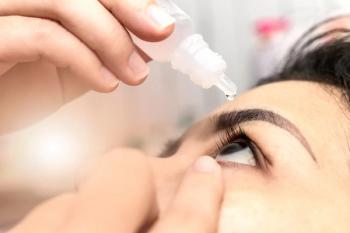
- Optometry Times October 2019
- Volume 11
- Issue 10
Dry eye signs may signal risk for diabetic foot ulcers
Consider a patient’s case history when conducting assessments for potential diagnosis
I practice in a multidisciplinary setting where professional collaborative engagement of all medical specialties is highly valued and practiced on a daily basis.
I learned about a new test from podiatrists on staff in our health centers called the Semmes-Weinstein 5.07 (10-gram) monofilament test for loss of protective sensation of diabetic/neuropathic feet.
The Semmes-Weinstein monofilament test (SWM) is a nylon filament calibrated so that it takes 10 grams of force to bend it when touched on the skin of the foot. An inability of the patient to detect this degree of force indicates that the client has a loss of protective sensation in the foot.
In 2008, a task force was built to consider the elements of a comprehensive foot and risk assessment of the patient with
The task force was comprised of the Foot Care Interest Group of the American Diabetes Association (ADA), with endorsement by the American Association of Clinical Endocrinologists (AACE).1Previously by Dr. Mastrota:
Foot exam considerations
The lifetime risk of a person with diabetes developing a foot ulcer may be as high as 25 percent, whereas the annual incidence of foot ulcers is < 2 percent.2
The most common triad of causes that interact and ultimately result in foot ulceration has been identified as neuropathy, foot deformity, and foot trauma.3
For the foot exam, case history is a pivotal component of risk assessment. A patient cannot be fully assessed for risk factors for foot ulceration based on history alone; a careful foot exam remains the key component of this process.
Noteworthy aspects of the patient history include previous foot ulceration or amputation. Other important assessments in the history include neuropathic or peripheral vascular symptoms, impaired vision, or renal replacement therapy.
Tobacco use should be recorded, as cigarette smoking is a risk factor not only for vascular disease but also for neuropathy.4
Eyecare providers know that beyond the associated retinal pathology,
Corneal neuropathy can lead to loss of corneal sensation and ultimately result in neurotrophic ulcers and significant visual morbidity.
The epithelial fragility and poor wound healing that result from reduced epithelial adhesion to the underlying basement membrane in diabetes-together with corneal neuropathy-are thought to increase the susceptibility to
To parallel, loss of corneal sensation (corneal hypoesthesia) can be quantified by the use of the handheld Luneau Cochet-Bonnet Aesthesiometer. The device, akin to the monofilament foot test, contains a thin, retractable, nylon monofilament. Variable pressure can be applied to the cornea by the device-quantifying corneal sensation-by adjusting the length. The monofilament ranges from 60 mm to 5 mm. As the length is decreased, the pressure increases from 11 mm/gm to 200 mm/gm.
This begs the question:
As guardians of a patient’s wellbeing-and in the current outcomes-driven medical environment-should ODs have patients with
Read more by Dr. Mastrota
References:
1. Bolton AJM, Armstrong DG, Albert SF, Frykberg RG, Hellman R, Kirkman SM, Lavery LA, LeMaster JW, Mills JL, Mueller MJ, Sheehan P, Wukich DK. Comprehensive foot examination and risk assessment: a report of the Task Force of the Foot Care Interest Group of the American Diabetes Association, with endorsement by the American Association of Clinical Endocrinologists. Diabetes Care. 2008 Aug; 31(8): 1679–1685.
2. Singh H, Armstrong DG, Lipsky BA. Preventing foot ulcers in patients with diabetes. JAMA. 2005 Jan 12;293(2):217-28.
3. Reiber GE, Vileikyte L, Boyko EJ, del Aguila M, Smith D, Lavery LA, Boulton AJ. Causal pathways for incident lower-extremity ulcers in patients with diabetes from two settings. Diabetes Care. 1999 Jan;22(1):157-62.
4. Clair C, Cohen MJ, Eichler F, Selby KJ, Rigotti NA. The effect of cigarette smoking on diabetic peripheral neuropathy: a systematic review and meta-analysis. J Gen Intern Med. 2015 Aug; 30(8): 1193–1203.
5. Reiber GE, Vileikyte L, Boyko EJ, del Aguila M, Smith DG, Lavery LA, Boulton AJ. Causal pathways for incident lower-extremity ulcers in patients with diabetes from two settings. Diabetes Care. 1999 Jan;22(1):157-62.
6. Markoulli M, Flanagan J, Tummanapalli SS, Wu J, Willcox M. The impact of diabetes on corneal nerve morphology and ocular surface integrity. Ocul Surf. 2018 Jan;16(1):45-57.
Articles in this issue
about 6 years ago
Lyme disease: The 45-year silent epidemicabout 6 years ago
Epi-on cross-linking may speed visual recoveryabout 6 years ago
30 years of LASIKabout 6 years ago
More than a yellow lesion?about 6 years ago
Go beyond medical treatment for recurrent corneal erosionabout 6 years ago
Toxoplasmosis shows varied diagnosisabout 6 years ago
Nutrition in the future of primary-care optometryabout 6 years ago
Artificial intelligence might be the future of practice managementabout 6 years ago
Why taking patient history never endsabout 6 years ago
Q&A: Academia, contact lenses, beer, climbing a water towerNewsletter
Want more insights like this? Subscribe to Optometry Times and get clinical pearls and practice tips delivered straight to your inbox.
















































.png)


